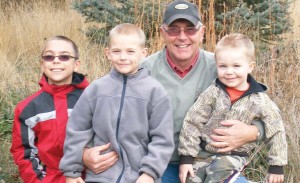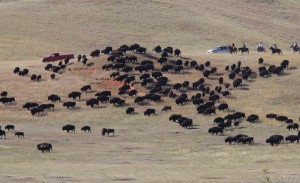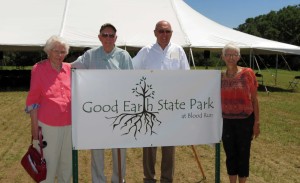’72 grad guides growth of State Park System
“Far and away the best prize that life has to offer is the chance to work hard at work worth doing.â€
This quote from Theodore Roosevelt, one of the presidents most closely associated with the development of the National Park Service, holds a special place in the heart of Doug Hofer ’72, who has guided the South Dakota State Park System for 30 years. “I’ve been blessed,†he said after offering up the Roosevelt quote.
All told, Hofer has a 43-year career with South Dakota Division of Parks and Recreation.
“If I had a chance to do it all over again, I would not even hesitate. I’d do it all over again,†said Hofer, who was one of the first graduates of the parks management program at State. “There only had been a handful of graduates before I graduated. They hired their first full-time professor in park management the year after I graduated.â€
Hofer wouldn’t have been among the grads if not for Burton Brage, the associate dean of agriculture.
Original interest: wildlife
Before classes started in fall 1968, Hofer and his dad, Verlyn, publisher of the Lennox newspaper, made a trip to Brookings to plan his classes. Hofer wanted to go into wildlife management because he so enjoyed the pheasant hunting to which his dad introduced him. Brage thought better of it.
That field was already saturated, why don’t you give this new and emerging parks management major a try, Hofer recalled  hearing.
hearing.
Parks management was first listed as a curriculum option in the horticulture major in 1965-66. It was first listed as a major in 1967-68.
Hofer, who turns 66 in June, is glad he didn’t resist. His tenure as director is longer than any of his predecessors as well as those in any other state. Furthermore, he hasn’t circled a retirement date. When it comes, you’ll probably find him camping along the Missouri with his kids and grandkids.
That—along with hunting and fishing with his grandchildren —is already Hofer’s idea of an ideal outing.
Eye on the future
Presently, Hofer is focused on making a good thing better. Seizing the opportunities is what keeps him awake at night.
“Managing the State Park System in South Dakota gives you the chance to work with the most iconic natural and historic resources found in our state—Fort Sisseton, Good Earth, Custer, Bear Butte, Lewis and Clark or any of the other 60 parks.
 “With those come opportunities to make them more accessible to the public, to share the story of the park and outdoor opportunities. Thinking about the ways to bring those things to fruition is what keeps me awake. There are a lot of different paths and finding the best path is really a challenge.â€
“With those come opportunities to make them more accessible to the public, to share the story of the park and outdoor opportunities. Thinking about the ways to bring those things to fruition is what keeps me awake. There are a lot of different paths and finding the best path is really a challenge.â€
So far, Hofer and the 130 full-time people he oversees have successfully negotiated that path.
In 1984, the year before Hofer became director, there were 60,000 overnight camping visits at 1,900 campsites. In 2014, there were 290,000 overnight camping visits at 4,200 campsites. In terms of overall park visitation, the State Park System hosted 3.2 million visitors in 1984 and 7.4 million in 2014.
“The State Park System’s growth and popularity are some of the things I’m most proud of being part of during my career,†Hofer said.
With its glacial lakes, the scenic Missouri River and the Black Hills, South Dakota has an abundance of inherently attractive camping destinations. Providing well-designed and equipped campgrounds, and good customer service enhances the natural draw and reputation of the South Dakota State Park System, Hofer said.
“People feel it is a good bargain and want to spend their time and resources there,†Hofer said of the state’s 63 state parks, recreation areas and nature areas.
User-financed system
It’s a good thing because the operation of the State Park System is mostly self-supporting. Hofer said that’s one area where his SDSU education has paid dividends.
“An emphasis was put on economics. I nearly had enough credits to have a minor in economics,†Hofer said. “Rocky Gilbert was a pretty colorful professor, and he turned economics into something that was a lot of fun. There’s a business side to every management job.
“Understanding the business model is something that has stuck with me my whole career. We have to run the parks like a business.â€
According to research by North Carolina State, the South Dakota system is one of the nation’s most efficient, Hofer said.
“The number of visitors we’re able to accommodate and still keep the cost of our operations down is something all of our staff really take pride in,†Hofer said. “We’re a state of about 800,000 people, and we served 7.4 million visitors last year. The main reason we’re able to do that is the users’ support of the system.â€
Park system’s big challenge
“We want to keep the parks affordable,†he said.
Right now, most campsites are in the range of $20 per night plus there is a vehicle entrance fee that can be paid on a daily ($6) or annual ($30) basis.
Hofer said the biggest challenge facing the system is to have the “resources necessary to invest in our infrastructure and do preventative maintenance. South Dakota is blessed with a wonderful State Park System. We not only have quality park resources, we have quality parks facilities.
“We must maintain that quality so future generations can be proud of what they have. It requires a continuing investment to do that,†Hofer said.
Dave Graves






